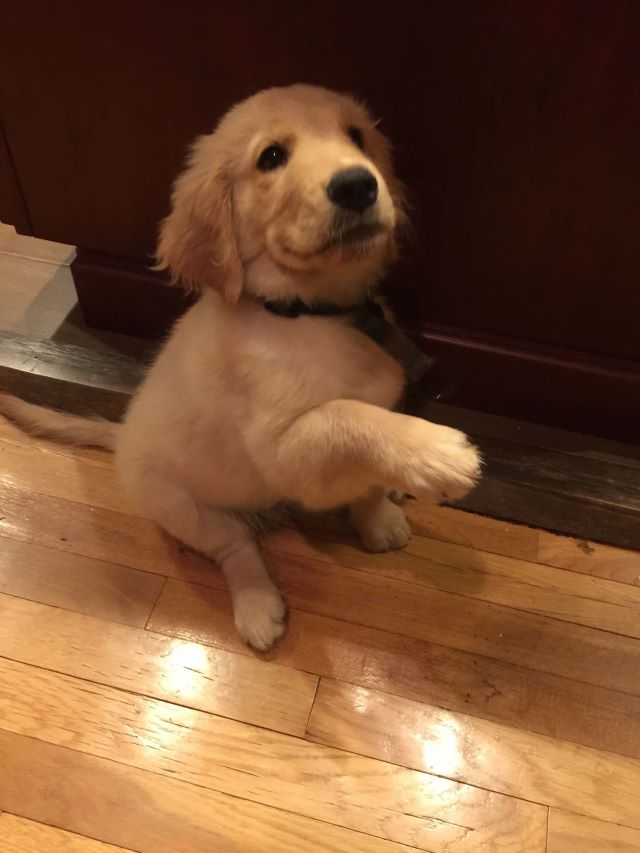The Golden Guide to Training your Golden Retriever
Golden Retrievers are beloved for their friendly nature, playful demeanor, and, of course, their luscious golden coats. These beautiful dogs are not just a pretty face; they are also known for their intelligence and eagerness to please. This combination of traits often leads to a common question among potential dog owners: Are Golden Retrievers easy to train? In this article, we’ll explore the world of Golden Retriever training and provide you with the Golden Guide to Training your Golden Retriever.
Are Golden Retrievers Easy to Train?
Yes, Golden Retrievers are generally considered one of the more trainable dog breeds. Their intelligence and friendly disposition make them receptive to learning new commands and tricks. However, the ease of training can vary from one Golden to another, as each dog has its own personality and temperament.
Factors that make Golden Retrievers easy to train:
- Intelligence: Golden Retrievers are among the smartest dog breeds, ranking fourth in Dr. Stanley Coren’s list of most intelligent dogs. Their ability to quickly grasp commands and understand tasks makes training a smoother process.
- Desire to Please: Golden Retrievers have a strong desire to please their owners. They thrive on positive reinforcement, such as treats, praise, and affection, which makes them highly motivated during training.
- Friendly Nature: Their friendly and sociable nature means they often get along well with trainers and other dogs, creating a positive training environment.
- Adaptability: Golden Retrievers are adaptable dogs, making them suitable for various training environments and situations.
- Energy Level: While they can be active, their energy levels are manageable, making them easier to handle during training sessions.
Factors that may pose challenges in training:
- Eagerness: Their eagerness to please can sometimes lead to excitement and impatience, causing them to lose focus during training.
- Attention Span: Young Golden Retrievers might have shorter attention spans, requiring shorter and more frequent training sessions.
- Distractions: Their friendly nature can also lead to distractions when they encounter other dogs or people during training.
Types of Training for Golden Retrievers
Now that we’ve established that Golden Retrievers are generally trainable, let’s explore the types of training you can do with your Golden companion.
1. Basic Obedience Training: Start with essential commands like sit, stay, come, and down. These commands are the foundation of good behavior and safety.
2. Clicker Training: Clicker training is an effective method for reinforcing desired behaviors through the use of a clicker to mark the exact moment your Golden does something right. It’s particularly useful for teaching tricks and complex behaviors.
3. Positive Reinforcement: Golden Retrievers respond incredibly well to positive reinforcement. Use treats, praise, and affection to reward good behavior, which encourages your dog to repeat those behaviors.
4. Socialization: Early socialization is crucial to help your Golden Retriever become well-adjusted and friendly with other dogs and people. Expose them to various situations and environments from a young age.
5. Agility Training: Golden Retrievers love physical activity. Consider agility training to keep them mentally and physically stimulated while strengthening your bond.
6. Retrieval Training: Leverage their natural retrieving instinct by teaching them to fetch and retrieve objects. This can be both fun and practical.
7. Advanced Training: Once your Golden has mastered the basics, you can explore advanced training such as therapy dog certification, search and rescue training, or even competitive obedience.
20 Commands to teach your Golden Retriever
1. Sit:
- Hold a treat in your hand and let your dog see and smell it.
- Stand in front of your dog and hold the treat just above their nose.
- Slowly move the treat upward and slightly backward over their head. As their head follows the treat, their bottom should naturally lower to the ground.
- The moment their bottom touches the ground, say “Sit” in a clear, firm voice and immediately give them the treat.
- Repeat this process several times, gradually reducing the need for a treat every time until your dog reliably sits on command.
2. Stay:
- Start with your dog in a sitting position.
- Hold your palm out, like a stop sign, in front of your dog and say “Stay” in a calm but assertive tone.
- Take a step or two backward. If your dog remains seated, reward them with praise and a treat.
- If they try to get up, return them to the sitting position and repeat the command.
- Gradually increase the distance and duration as your dog becomes more comfortable with the stay command.
3. Come:
- Begin in a quiet, enclosed area to minimize distractions.
- Get down to your dog’s level and say “Come” in an enthusiastic and inviting tone.
- You can crouch down, pat your thighs, or use a toy to encourage them to come to you.
- When your dog comes to you, reward them with praise and a treat.
- Practice this command in different locations and gradually increase the level of distraction as your dog becomes more reliable.
4. Down:
- Start with your dog in a sitting position.
- Hold a treat close to their nose and slowly lower it straight down to the ground between their front paws.
- As your dog follows the treat, their body should naturally lower to the ground.
- Once they are lying down, say “Down” in a clear voice and give them the treat and praise.
- Repeat the process, gradually reducing the need for treats each time.
5. Leave It:
- Place a treat in your closed hand, letting your dog see and smell it.
- Present your closed hand to your dog and say “Leave it” firmly.
- Your dog may attempt to paw at or sniff your hand. Ignore these attempts.
- Once your dog stops trying to get the treat and looks away, praise them and give them a different treat from your other hand.
- Repeat this exercise, gradually increasing the value of the item you ask them to “leave” (e.g., a favorite toy or a piece of food).
6. Stay (Advanced):
- After your dog has mastered the basic “Stay” command, you can make it more challenging by increasing the duration and introducing distractions.
- Ask your dog to “Stay” while you take a step back, then return to them and reward with a treat.
- Gradually increase the distance and the amount of time your dog must stay. Ensure they remain seated until you give them the release command, like “Okay” or “Free.”
7. Heel:
- Use a leash and start walking with your dog on your left side.
- Hold the leash with both hands, keeping it short but loose.
- Say “Heel” and start walking. If your dog tries to pull ahead, stop walking and wait for them to return to your side.
- When they are walking beside you without pulling, reward them with treats and praise. Repeat consistently during walks.
8. Off (for Jumping):
- When your dog jumps on you or others, say “Off” firmly.
- As soon as they have all four paws on the ground, praise them and reward with a treat or affection.
- Consistency is key – encourage everyone in your household to use the same command and reward system.
9. Drop It (for Retrieving Objects):
- Start with a toy your dog likes to retrieve.
- Play with your dog and the toy. When they have the toy in their mouth, say “Drop it” in a calm but assertive tone.
- If they don’t drop it, gently hold a treat close to their nose to encourage them to release the toy. When they do, praise and reward with the treat.
- Gradually increase the time they hold the object before giving the “Drop it” command.
10. Speak and Quiet (for Barking):
- To teach your dog to speak, wait for them to naturally bark. As soon as they do, say “Speak” and reward with a treat.
- To teach them “Quiet,” wait for them to stop barking. As soon as they do, say “Quiet” and reward with a treat.
- Practice these commands during times when you can control the barking situation, like during playtime or when someone is at the door.
11. Place (for Settling on a Mat or Bed):
- Choose a designated mat or bed for your dog to settle on.
- Lead them to the mat using a leash or by guiding them with treats.
- Say “Place” as they step onto the mat, and reward them with treats and praise.
- Encourage them to stay on the mat for gradually longer durations, using the “Stay” command if needed.
12. Spin:
- Hold a treat in front of your dog’s nose.
- Slowly move the treat in a circular motion, encouraging your dog to follow it.
- As your dog completes the circle, say “Spin” and reward them with the treat.
- Practice in both directions for a fun trick.
13. Paw/Shake Hands:
- Ask your dog to sit.
- Hold a treat in your hand and present it to your dog, just out of reach.
- Say “Paw” or “Shake hands” and tap their paw with your hand.
- When they offer their paw, shake it gently and reward them with the treat.
14. Roll Over:
- Start with your dog in a lying down position.
- Hold a treat close to their nose and slowly move it in a circle over their shoulder.
- As they follow the treat and roll onto their back, say “Roll over” and reward them with the treat.
- This command may take some time to master, so be patient and use gentle guidance.
15. High Five:
- Have your dog sit or stand in front of you.
- Hold a treat in your hand and raise it slightly above their head.
- Say “High five” and encourage them to reach up with their paw to touch your hand.
- Reward them with the treat when they make contact.
16. Crawl:
- Start with your dog in a down position.
- Hold a treat close to their nose and slowly move it forward along the ground.
- As they follow the treat and crawl forward, say “Crawl” and reward them with the treat.
- This command can be a fun variation of “Down.”
17. Find It (Scent Work):
- Hide treats or toys around a room and let your dog watch you do it.
- Say “Find it” and encourage your dog to search for the hidden items.
- Praise and reward them when they discover the hidden treats or toys.
- This exercise stimulates their natural hunting instincts and mental acuity.
18. Touch/Target Training:
- Present an object (e.g., a target stick, your hand, or a specific item) to your dog.
- When your dog touches the object with their nose or paw, say “Touch” or “Target.”
- Reward them with a treat or praise.
- This command can be useful for teaching more advanced behaviors.
19. Bow:
- Start with your dog in a standing position.
- Hold a treat near their nose and slowly move it down toward the ground.
- As your dog bends forward, say “Bow” and reward them with the treat.
- This trick showcases their flexibility and is a playful command.
20. Stay with Distractions:
- Once your dog has mastered basic “Stay,” gradually introduce distractions like toys, food, or other people.
- Use the “Stay” command and reward them for maintaining their position despite the distractions.
- This reinforces their self-control and obedience in real-world situations.
Remember to keep training sessions fun, positive, and rewarding. Each dog is unique, so adapt your training techniques to suit your Golden Retriever’s personality and abilities. Consistency and patience are key to success, and always prioritize your dog’s enjoyment and well-being during training.
Golden Retrievers are indeed easy to train, thanks to their intelligence, eagerness to please, and friendly disposition. However, successful training depends on consistency, patience, and positive reinforcement. Keep in mind that every dog is unique, and training experiences may vary. By investing time and effort into training your Golden Retriever, you’ll not only have a well-behaved companion but also strengthen the bond between you and your furry friend, ensuring many happy moments together.



